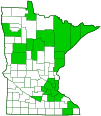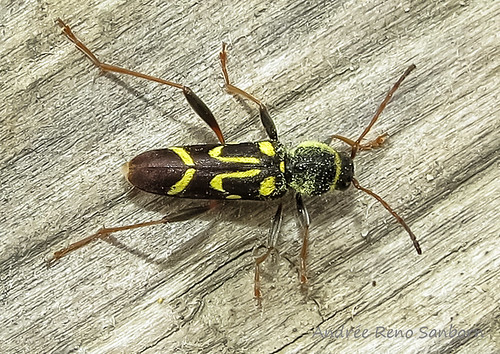round-necked longhorn beetle
(Clytus ruricola)
Conservation • Description • Habitat • Ecology • Distribution • Taxonomy
Conservation Status |
|
|||||||
| IUCN Red List | not listed |
|||||||
| NatureServe | NNR - Unranked |
|||||||
| Minnesota | not listed |
|||||||
Description |
||
Round-necked longhorn beetle is a common, medium-sized, wood boring beetle. It occurs in the United States from Maine to northern South Carolina, west to Minnesota, Illinois, and Georgia. It also occurs in southern Canada from Nova Scotia west to Alberta. Adults are found from May to early August in deciduous forests. They feed on the pollen of many flowers in numerous plant families. The larvae feed on the rotting wood of hardwoods, especially maple. Adults are ⅜″ to ⅝″ (10 to 15 mm) in length. They are black with bright yellow markings. When in flight they resemble a yellowjacket or paper wasp. This is an example of Batesian mimicry, mimicking the defensive coloration of a defended species. The body is elongated, rather robust, and somewhat cylindrical. It is constricted between the thorax and the abdomen, forming a distinct rounded “neck”. The head is large and entirely black. The face is slanted forward or nearly vertical. There is no ridge (carina) on the front of the head. The compound eyes are deeply notched. The small antennae-like structures (palps) emerging from the lower jaws (maxillae) are blunt or straight across at the tip, not pointed. The antennae are slender, thread-like, and long, at least half as long as the body. They are mostly reddish-brown but the last 4 to 5 segments are black. The exoskeletal plate covering the thorax (pronotum) is black, rounded on the sides, widest near the middle when viewed from above, and strongly convex when viewed from the side. It is densely pitted (punctate), but it does not have a transverse ridge. There is a single, narrow, yellow band on the front and lateral margins that extends only slightly onto the rear margin on each side. The small plate between the wing bases (scutellum) is yellow. The hardened forewings (elytra) are broad at the base, round at the tips, and black with yellow markings. On each elytron there is an oblique, oval spot in the basal third; a U-shaped band extending from the inner margin (suture), back to the middle, then forward and outward to near the leading edge (costal margin); and an oblique bar beyond the middle. The legs are long and mostly reddish-brown. The third segment (femur) on each leg is narrow and reddish-brown at the base, swollen (clubbed) and black from the middle to the tip. The last part of each leg (tarsus), corresponding to the foot, has five segments. The first segment is very long. The fourth segment is very short and is concealed within the lobes of the heart-shaped third segment, making the tarsus appear to have only four segments. |
||
Size |
||
Total length: ⅜″ to ⅝″ (10 to 15 mm) |
||
Similar Species |
||
Habitat |
||
woodlands |
||
Ecology |
||
Season |
||
One generation per year: May to early August |
||
Behavior |
||
|
||
Life Cycle |
||
|
||
Larva Food |
||
Rotting wood of hardwoods, especially maple |
||
Adult Food |
||
Flower pollen |
||
Distribution |
||||
|
Sources |
|||
| 7/1/2023 | ||||
Occurrence |
||||
|
||||
Taxonomy |
|||
Order |
Coleoptera (Beetles) | ||
Suborder |
Polyphaga (Water, Rove, Scarab, Long-horned, Leaf, and Snout Beetles) | ||
Infraorder |
Cucujiformia | ||
Superfamily |
Chrysomeloidea (longhorn beetles and allies) | ||
Family |
Cerambycidae (longhorn beetles) | ||
Subfamily |
Cerambycinae (round-necked longhorn beetles) | ||
Tribe |
Clytini | ||
Genus |
Clytus | ||
Synonyms |
|||
Clytanthus ruricola |
|||
Common Names |
|||
field long-horned beetle round-necked longhorn beetle |
|||
Glossary
Costal margin
The leading edge of the forewing of insects.
Elytra
The hardened or leathery forewings of beetles used to protect the fragile hindwings, which are used for flying. Singular: elytron.
Femur
On insects and arachnids, the third, largest, most robust segment of the leg, coming immediately before the tibia. On humans, the thigh bone.
Maxillae
Paired mouth structures of arthropods located immediately behind the mandible and used for tasting and manipulating food. “Under-jaws”.
Palp
Short for pedipalp. A segmented, finger-like process of an arthropod; one is attached to each maxilla and two are attached to the labium. They function as sense organs in spiders and insects, and as weapons in scorpions. Plural: palpi or palps.
Pronotum
The exoskeletal plate on the upper side of the first segment of the thorax of an insect.
Punctate
Dotted with pits (punctures), translucent sunken glands, or colored spots of pigment.
Scutellum
The exoskeletal plate covering the rearward (posterior) part of the middle segment of the thorax in some insects. In Coleoptera, Hemiptera, and Homoptera, the dorsal, often triangular plate behind the pronotum and between the bases of the front wings. In Diptera, the exoskeletal plate between the abdomen and the thorax.
Tarsus
On insects, the last two to five subdivisions of the leg, attached to the tibia; the foot. On spiders, the last segment of the leg. Plural: tarsi.
Visitor Photos |
|||||
Share your photo of this insect. |
|||||
| This button not working for you? Simply email us at info@MinnesotaSeasons.com. Attach one or more photos and, if you like, a caption. |
|||||
Greg Watson |
|||||
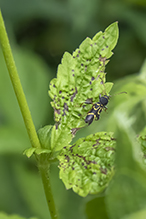 |
|||||
MinnesotaSeasons.com Photos |
|||||
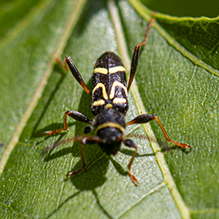 |
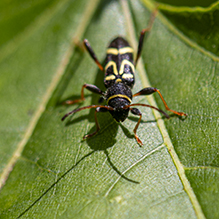 |
||||
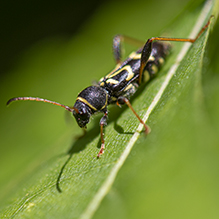 |
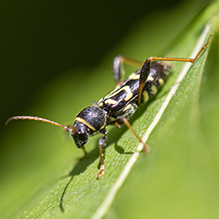 |
||||

Visitor Videos |
|||
Share your video of this insect. |
|||
| This button not working for you? Simply email us at info@MinnesotaSeasons.com. Attach a video, a YouTube link, or a cloud storage link. |
|||
Other Videos |
|||
| Round-necked Longhorn Beetles (Cerambycidae: Clytus ruricola) Carl Barrentine |
|||
About
Jun 16, 2010 Photographed at the Rydell NWR, Minnesota (16 June 2010). |
|||
| LONGHORN BEETLE Clytus ruricola Rob Curtis |
|||
About
Jul 20, 2019 Clytus ruricola CERAMBYCINAE LONGHORN BEETLE, McClaughery Springs FP, 7/3/2019 |
|||

Created: 7/1/2023
Last Updated:
